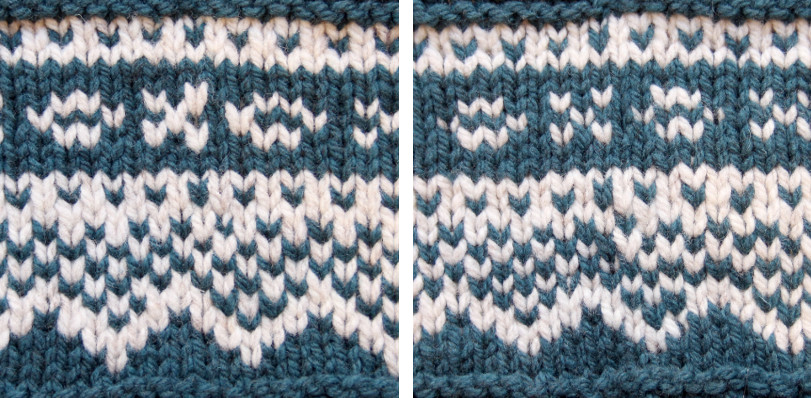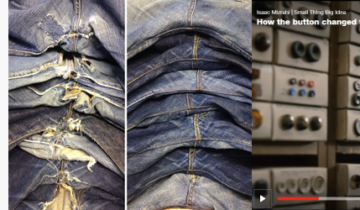Like many new colourwork knitters, when I begun my Half Moon Tee I forgot to account for the difference in tension between my stockinette and stranded sections. My colourwork sections were too tight which resulted in the right side of the fabric puckering, this not only makes the motif uneven but can also change the overall tension which leads to the final fit of the garment. On the other hand, some new colourwork knitters make the floats too loose which can result in a fabric with not enough structure, gaps in between colour changes and a stranded motif lacking of definition.

Getting your tension and floats even takes practice but there are few tricks that will help you managing your floats and tension to ensure a neat result.
The first step, as always, is to swatch your fabric. I, like many knitters, am guilty of skipping this step but I’m slowly learning to take a moment of my time to swatch before I begin my project. The pain of making something as complicated as a garment that ends up too big or too small is never ever going to be worth the evening used to knit a swatch.
The distinction between swatching in the round rather than flat is an important one. Knits and purls are worked differently so it is common for them to come out slightly different sizes. When knitting a common stitch, like stocking stitch, the tension can be quite different between knitting it flat (purling on the wrong side) and knitting it in the round (no purling). You should always knit your swatch the way the project is knitted.
The most accurate way is to knit a swatch with floats.
- On a circular needle cast on enough stitches that you will be able to measure 10 cm (4 in) in the middle of the swatch. This method does leave messy edges.
- Instead of turning the work slide the stitches to the opposite end of the needle, keeping the right side facing you. Like you would if you were knitting an icord.
- Pull the working yarn around the back of the work keeping it loose behind the stitches and start knitting the next row.
- Repeat this, moving the stitches across and draping the working yarn around the back. Don’t worry if the floats get a bit tight, you can cut these after casting off so the swatch will sit nice and flat for measuring. I would recommend washing the swatch before cutting the floats just to be sure nothing unravels from the sides.

After swatching there are a couple of other things you can do to help even out your tension when knitting stranded.
1. Spread your stitches across your needle.
Before swapping colours spread your stitches evenly across your right needle. This will insure the float behind spreads across the full width of the stitches.
2. Knit inside out!
Turn your work inside out so the wrong side of the fabric is facing out and keep knitting as normal. If you think of your circle of knitting like a running track, the inside lane is a shorter distance than the outside lane. So by having the wrong side of the knitting on the outside the floats have to ‘travel’ a longer distance in between stitches. If the float is long enough to cover the stitches this way around it will definitely be long enough when you’ll turn it back in. This can be particularly helpful when knitting small circumferences like sleeves.
3. Go up a needle size.
An easy way to counteract tight tension, although this won’t help keep your floats loose, is to go up a needle size when working the colourwork section of your pattern. This can work especially well when your pattern changes from colourwork to plain knitting. As long as your gauge is still the same as the one recommended, you’re good to go.
Colour dominance is another point to consider for even knitted colourwork.
To make sure the motif section of the pattern stands out against the background you need to ensure that the motif colour is dominant. Colour charts in some patterns will helpfully specify which colour in the pattern is the dominant one in each row, but not all do including Yell. In a two-colour pattern the motif should be dominant, but in a pattern involving multiple colours maybe you might need to think a bit harder. Dominance may also vary and a colour that is dominant on one row may become a background colour on the next.

Colour dominance results from the way the colours are stranded in relation to one another. The dominant colour should always be stranded below the background colour. By being held below the other colour the dominant colour is given a slightly longer float. Some of that extra float translates into the stitches giving them a fuller and bigger appearance. On the photo above the white has been stranded as the dominant on the left and as the background on the right. We can clearly see the impact it has on the motif which looks plumper on the left than it does on the right.
Until Next Time… Happy Knitting!




 No products in the basket.
No products in the basket.